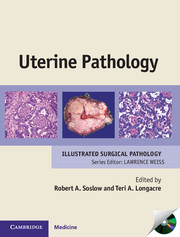Book contents
- Frontmatter
- Contents
- List of contributors
- Preface
- Acknowledgments
- 1 Cytology of the uterine cervix and corpus
- 2 Cervix: squamous cell carcinoma and precursors
- 3 Cervix: adenocarcinoma and precursors, including variants
- 4 Miscellaneous cervical abnormalities
- 5 Non-neoplastic endometrium
- 6 Endometrial carcinoma precursors: hyperplasia and endometrial intraepithelial neoplasia
- 7 Endometrioid adenocarcinoma
- 8 Serous adenocarcinoma
- 9 Clear cell adenocarcinoma and other uterine corpus carcinomas, including unusual variants
- 10 Carcinosarcoma
- 11 Adenofibroma and adenosarcoma
- 12 Uterine smooth muscle tumors
- 13 Endometrial stromal tumors
- 14 Other uterine mesenchymal tumors
- 15 Miscellaneous primary uterine tumors
- 16 Uterine metastases: cervix and corpus
- 17 Gestational trophoblastic disease
- 18 Other pregnancy-related abnormalities
- 19 Lynch syndrome (hereditary non-polyposis colorectal cancer syndrome)
- 20 Cytology of peritoneum and abdominal washings
- Index
- References
3 - Cervix: adenocarcinoma and precursors, including variants
Published online by Cambridge University Press: 05 July 2013
- Frontmatter
- Contents
- List of contributors
- Preface
- Acknowledgments
- 1 Cytology of the uterine cervix and corpus
- 2 Cervix: squamous cell carcinoma and precursors
- 3 Cervix: adenocarcinoma and precursors, including variants
- 4 Miscellaneous cervical abnormalities
- 5 Non-neoplastic endometrium
- 6 Endometrial carcinoma precursors: hyperplasia and endometrial intraepithelial neoplasia
- 7 Endometrioid adenocarcinoma
- 8 Serous adenocarcinoma
- 9 Clear cell adenocarcinoma and other uterine corpus carcinomas, including unusual variants
- 10 Carcinosarcoma
- 11 Adenofibroma and adenosarcoma
- 12 Uterine smooth muscle tumors
- 13 Endometrial stromal tumors
- 14 Other uterine mesenchymal tumors
- 15 Miscellaneous primary uterine tumors
- 16 Uterine metastases: cervix and corpus
- 17 Gestational trophoblastic disease
- 18 Other pregnancy-related abnormalities
- 19 Lynch syndrome (hereditary non-polyposis colorectal cancer syndrome)
- 20 Cytology of peritoneum and abdominal washings
- Index
- References
Summary
INTRODUCTION
While the overall age-adjusted incidence of cervical squamous cell carcinoma has declined in countries that have implemented organized cervical Pap smear surveillance programs, the incidence of adenocarcinoma and adenosquamous carcinoma has increased considerably from 1.30 and 0.15 cases per 100 000 women, respectively, in 1970–1972, to 1.83 and 0.41 per 100 000 women in 1994–1996. Moreover, the overall increase in incidence has been observed primarily in women less than 50 years of age. Although initial increases were attributed to increasing prevalence of persistent oncogenic HPV infection (and its cofactors) as well as inherent limitations of cervical cytology in detecting precursor glandular lesions, recent data indicate that cytologic screening, if performed and interpreted properly, can detect these early lesions. In fact, the decrease in glandular lesions of the cervix observed in several countries during the latter part of the 1990s strongly suggests that cytology screening is detecting more preinvasive adenocarcinomas than in previous decades, and further suggests that screening may be starting to have a protective impact on adenocarcinoma.
However, diagnostic issues concerning cervical glandular lesions continue to plague the cytopathologist and surgical pathologist. The key problematic areas revolve around (1) the diagnosis of adenocarcinoma in situ and the exclusion of benign mimics; (2) the presence of early or superficially invasive adenocarcinoma (we do not use the term “microinvasive adenocarcinoma”); (3) identification of the primary site of origin of problematic glandular proliferations in uterine samplings: that is, is it cervical, or endometrial, or metastatic; and (4) special variants.
- Type
- Chapter
- Information
- Uterine Pathology , pp. 34 - 69Publisher: Cambridge University PressPrint publication year: 2012



